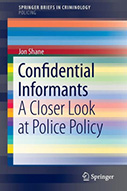Confidential Informants: A Closer Look At Policy

Author: Jon Shane
Publisher: Cham, SWIT: Springer, 2016. 112p.
Reviewer: Lloyd Klein | May 2018
There are areas where we can truly claim that there is a void in the literature. Such is the case for policing and confidential informants. Shane does a masterful job in offering a concise and expert guide into the important area of confidential informants. This short volume, a contribution within the Springer Briefs in Criminology with specific focus on policing, incorporates a pithy but very powerful view of the subject. He offers a short and effective introduction citing legal cases and some of the salient issues in policing requiring the use of confidential informants. Issues of reliability and collaboration of information are clearly important in Shane’s caveats on the use of police informants. As Shane points out, there is a double-edged sword where informants are encouraged to provide information but remain unpunished if the information proves to be incorrect. The necessity for invisibility and protection of the source is a clear priority over accuracy.
The main text of this brief analysis offers an important perspective on how prospective confidential informants establish veracity and accountability. The legal cases cited here are invaluable for the use of scholars and researchers in understanding the role of informants. The subsequent typology offered in another section is informative – providing an understanding of the informant as hammered (pressed into service), mercenary (motivated by money), vengeful (exacting revenge against other citizens or criminals), and being police buffs (those that enjoy interactions with law enforcement). The rationalization of such activity is backed up with appropriate references to established theoretical positions and published studies on justifications as a form of legitimate behavior.
Shane’s main points focus on how we define police informants and the issues of lying and deception. Law enforcement clearly needs the information provided by informants and realizes the liability of trusting individuals who may have tarnished or untrustworthy reputations. Police policies are clearly needed to establish a procedure for identifying prospective informants and rationalizing procedures for protecting such informants and paying individuals for their service. Integrity testing is a key issue in maintaining some level of trust in the work of confidential informants. As Shane points out, the process can go awry with corruptive practices at some levels of police bureaucracy.
Shane offers an impressive methodology section where he analyzes various states and their adherence to published confidential informant policies and accreditation standards. His utilization of specific research questions enables the analysis of integrity testing and an accepted IACP (International Association of Chiefs of Police) model. The various categories of professionals willing to assist law enforcement and others that may come from criminal backgrounds on the street, and the utilization of accountability procedures and controls are discussed here.
Finally, Shane focuses his analysis in terms of policy implications including the prevention of organizational errors, a focus on police legitimacy, integrity training, and best practices. Shane poses important questions on how this reliance on confidential informants can be expanded in sectors such as implicit management of the process and with respect to jailhouse informants.
Overall, this is an important study of an unexplored area of policing. The use, abuse, and managerial problems in such a practice are well documented. This volume is invaluable for the compilation of important policing resources and relevant judicial decisions on policing behavior. The book is recommended for scholars and law enforcement officials requiring guidance in a frequently utilized but not always aptly applied utilization of confidential informants.


